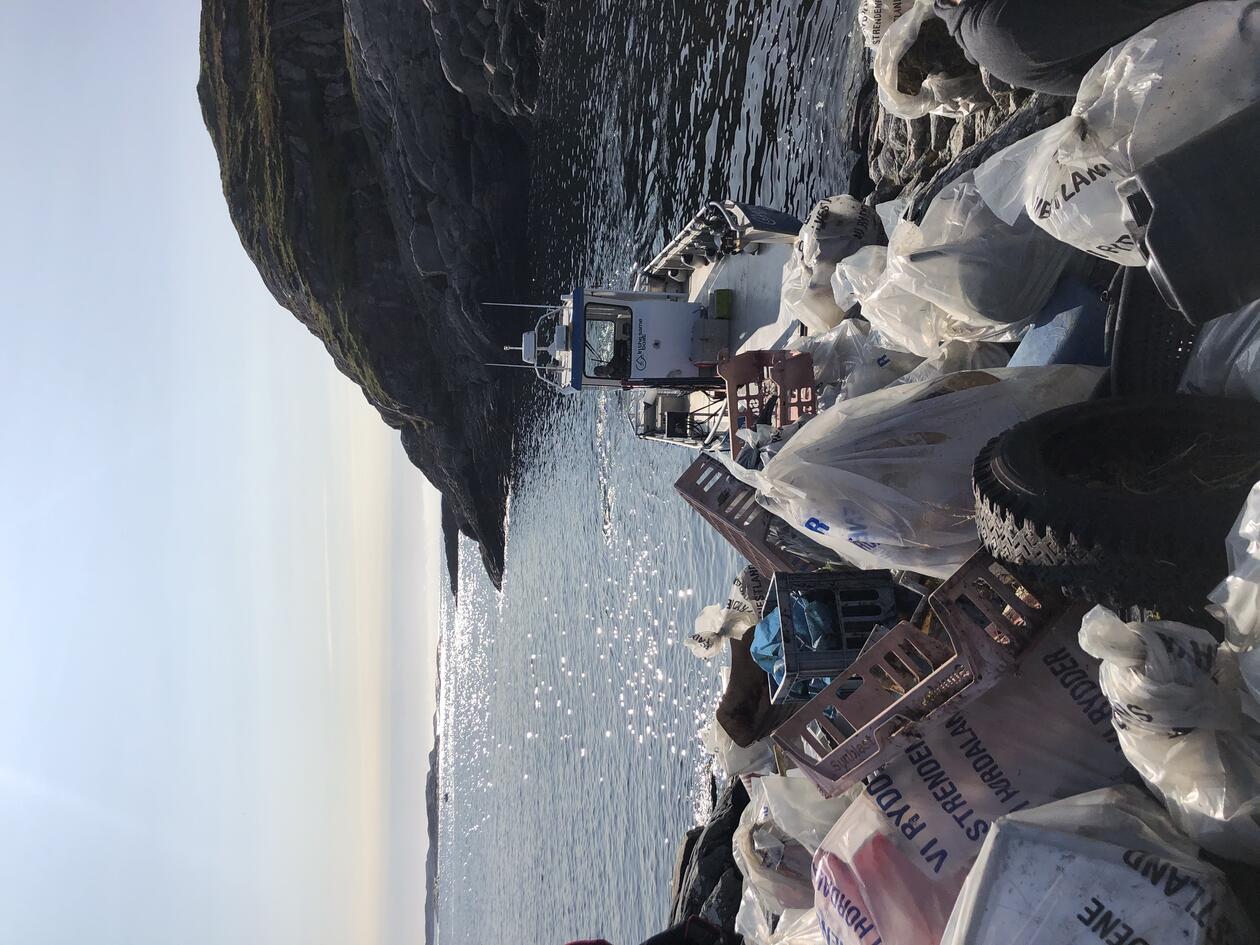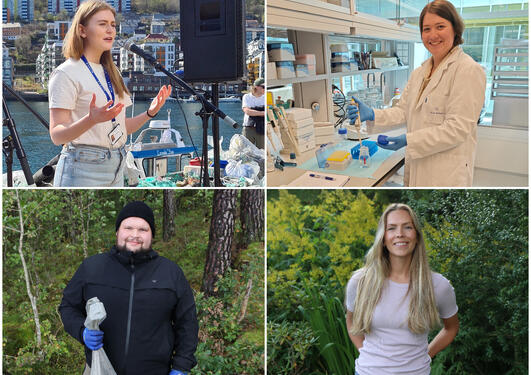Masteroppgaver
Vil du skrive masteroppgaven din om plast?

Main content
Plast er et materiale med mange gode egenskaper, samtidig produseres det enorme mengder avfall som havner i miljøet, til skade for både fisk, dyreliv og økosystem. Det er også kjent at mikroplast havner i mennesker, ofte via middagsfatet, men hvilke konsekvenser det eventuelt har for vår helse, er for tidlig å si.
Dette er et globalt problem, der bredden av universitetet sine fagområder kan bidra med ny forskningsbasert kunnskap. Om du er student og ønsker å skrive masteroppgave med plast som tema, har du flere muligheter på de ulike fakultetene ved UiB.
Se noen aktuelle masteroppgaver her:
BIOLOGI
Plastic degrading microbes from Arctic deep-sea hydrothermal vents
Did you know that the deep-sea hydrothermal vents along the spreading ridges are Earth’s own bioreactor? Life at these sites is flourishing and harbors a vast biodiversity. Although primary production at the vents is fueled by the chemical energy from the vent fluids, deep-sea hydrothermal systems have shown to harbor microbes able to degrade recalcitrant materials and enzymes targeting degradation of lignocellulose have been successfully characterized from these sites. Hydrothermal systems are also rich in hydrocarbons found in oil and natural gas, and naturally also present in oil-derived plastics. Thus, these environments are promising sites for discovery of plastic degrading microorganisms towards bioremediation for waste re-cycling.
Master projects in our group related to plastic degradation may involve the following topics:
- Setting up new enrichment cultures of plastic degrading bacteria/archaea using
sediment slurries from the Arctic Mid-Ocean Ridge hydrothermal vent fields.
- Nanopore long-read sequencing
- Fluorescence In Situ Hybridization microscopy (FISH)
- In silico enzyme screening using amongst others the olastic degrading enzyme
database (PAZyDB- https://pazy.eu/doku.php ).
- Cloning, expression and initial characterization of target enzymes; i.e PETases.
If this sound interesting, please contact Runar Stokke in the Deep-Sea Biology group, 5th floor
B-building at BIO, or simply write an email to runar.stokke@uib.no.
Projects related to the presence, fate and toxicity of plastic pollution and associated chemicals
Plastic and microplastic pollution are a muti-faceted environmental crisis as evidenced by the ongoing negotiations of a Global Plastics Agreement. The research area is expanding with more questions being posed as we find out more about the environmental presence, fate and effect of plastics. Novel polymer particles including tire wear particles, nanoplastics, paint fragments, cigarette butts have come more into focus. Plastics have added to them 1000s of chemicals at the manufacturing stage and then once released may sorb many other chemical groups (metals, pharmaceuticals, organic pollutants). The timeliness of global action and the complexity of plastics as a pollutant makes this research topic one of the most important and fast moving of our time. My research looks at many aspects of microplastic/plastic pollution from the environmental presence, toxicological and physiological effects on aquatic species, regulatory perspectives and societal impacts including citizen science projects. I am looking to develop project ideas (can be experimental or literature based) with enthusiastic students who view plastics as an important global threat. Happy to discuss specific ideas in greater detail.
Supervisor: Farhan R Khan, NORCE Climate and Environment
Contact: fakh@norceresearch.no
See my research: https://www.researchgate.net/profile/Farhan-Khan-29 and https://scholar.google.co.uk/citations?user=ASMWN3UAAAAJ&hl=en&oi=ao
Endocrine disruptive effects of plastic additives
Plastics contain a vast number of different chemicals. Most of these are added during production and serve specific functions, such as making the product stronger, transparent, UV-resistant, heat-resistant, colorful, or reduce the flammability of the material. However, during degradation of mismanaged plastics these additives may leak into the environment and accumulate in wildlife. It has been demonstrated that some plastic additives can cause endocrine disruption. One mechanism of how this can happen is through binding to specific hormone receptors by mimicking endogenous hormones. Bisphenol A (BPA) is a plastic additive used in the production of polycarbonate plastics. We have recently shown in our laboratories that bisphenol A and several of its suggested replacement compounds (BPB, BPC etc.) have strong estrogenic and anti-androgenic properties in Atlantic cod. There are currently several research projects in our group where it is relevant to follow up on these observations and assess for endocrine disruptive properties of plastic additives in different species, including whales (killer whale, fin whale), polar bear, zebrafish, polar cod, medaka, glaucous gull, and human. Master projects related to this research can for instance include culturing of cells and organs and analyzing their response to plastic additive exposure (viability/cytotoxicity, gene and protein expression), cloning of hormone receptors and establishing in vitro assays for studying plastic additive-mediated receptor activation, bioinformatic analyses and 3D-modelling of hormone receptor and plastic additive protein-ligand complexes. These master projects will be part of the Environmental Toxicology research group at the Department of Biological Sciences and are highly relevant for both molecular biology and biology students.
Please contact Odd André Karlsen or Anders Goksøyr if you want to know more.
FYSIKK OG TEKNOLOGI
Avrenning fra ulike typer plastoverflater
Studere avrenning fra ulike typer plastoverflater når de utsettes for vann (vanndråper eller kontinuerlig vannstrøm).
Veileder Lars Egil Helseth
Sensorer for detektering av små plastpartikler
Lage sensor som kan kobles direkte til mobiltelefonen for å detektere små plastpartikler. Se på muligheten for å lage en sensor (ved hjelp av optikk og et piezoelement) for å måle både masse og størrelse på små plastpartikler.
Veileder Lars Egil Helseth
Oppholdstid av mikroplast i Arktis
Fordeling av mikroplast i havet er et forurensingsproblem som hittil er lite studert. Konsekvensene for marint liv er potensielt store, og den geografiske fordelingen er stor grad ukjent. Ved bruk og tilpassing av trajektoriemodellen OpenDrift (se www.github.com/opendrift) vil studenten gjøre studier av oppholdstid for plast i Norskehavet og Polhavet. Kilder for mikroplast er gjenstand for debatt, og det vil være nødvendig å sette seg inn i litteraturen for å definere realistiske problemstillinger. Modellen er skrevet i Python, og det forventes at studenten ser på koden og evt gjør mindre justeringer og tilpassinger for å se på hvordan plastpartikler påvirkes av turbulens og tetthet i havet.
Veileder Øyvind Breivik
Stranding av makroplast
Stranding av store objekter (makroplast) er et stort forurensingsproblem med konsekvenser for marint liv og strandsonen. Studenten vil implementere en ny strandingsalgoritme i trajektoriemodellen OpenDrift (se www.github.com/opendrift). Det forventes at studenten gjør kjøringer av modellen for å se på sensitivitet av stranding av makroplast langs kysten av Nord-Europa og norskekysten.
Veileder Øyvind Breivik
Mikroplast og fluorescens.
Fluorescerer enkelte typer plast? Kan fluorescerende pigmenter tas opp av plasten, og deretter detekteres? Dette kan knyttes til forsøk der mikroalger og plankton blir utsatt for fluorescerende plastpartikler for å se om disse påvirker negativt, f.eks om de spises og tar plassen til næring.
Veileder Arne Kristoffersen
Partikkeltelling og størrelsesdistribusjon i vann
Ved hjelp av laser diffraksjon kan plastpartikler (over 2 mikrometer) detekteres av instrumenter som kan senkes i havet. Usikkert på konsentrasjoner i havet, men dette kan kanskje knyttes til forsøk med hvordan UV-stråling bryter ned plastpartikler.
Veileder Arne Kristoffersen
GEOGRAFI
Plastic in the loop
Countries in Europe and elsewhere have launched action plans for a circular economy to ensure that resources are used and kept in production systems for as long as possible. This topic may address companies’ life cycle thinking throughout the entire value chain from sourcing, disposal and waste collection on different geographical contexts and scales. This suggested project linked to Economic geography at the Department of Geography could study the Management of plastic waste with a circular economy approach. Our next admission to the Master program in Geography is fall 2023.
For further information about the topic contact professor Grete.Rusten@uib.no
For practical details about the enrollment contact Study Advisor Grethe.Meling@uib.no
JUS
MATEMATIKK
Reduserte transport modeller for plast
For å simulere transport av partikler i havet eller i fjorder, kreves ofte tunge modeller som løser væskeligningene numerisk. Hvis partiklene ikke påvirker strømforholdene, og formålet er å få en statistisk oversikt over hvor partiklene gjør av seg, kan modellene forenkler betraktelig. Oppgaven blir å bygge en statistisk representasjon av strømforhold i et område, basert på simuleringer vhja en sirkulasjonsmodell, og bruke denne representasjonen i en forenklet transport modell. Ved bruk Monte Carlo metoder vil formålet være å finne sannsynlige området hvor plasten strander.
Mer informasjon
Facts project (jpi-oceans-facts.eu)
NAMC - North Atlantic Microplastic Centre - Norce (norceresearch.no)
Veileder: Guttorm Alendal

